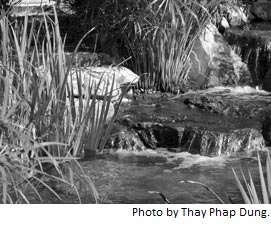By Valerie Brown in November 2003
Growing up on the streets of New York City, I learned the rules of engagement at an early age, I learned to live tough and play even tougher. Violence, distrust, and anger hung around my neighborhood like the Mister Softee truck on a warm summer day.
Mindfulness and awareness were as foreign to me as an uncharted journey to a distant pole.
By Valerie Brown in November 2003
Growing up on the streets of New York City, I learned the rules of engagement at an early age, I learned to live tough and play even tougher. Violence, distrust, and anger hung around my neighborhood like the Mister Softee truck on a warm summer day.
Mindfulness and awareness were as foreign to me as an uncharted journey to a distant pole. I was schooled in street rhythms, and learned that the world was unsafe, hostile, and filled with people who could not be trusted. Reflecting back, I realize that these feelings were rooted in a lack of safety and need for protection which stayed with me into adulthood, becoming habits of the heart, hardening my personality. I avoided intimacy, pushing people away like bits of uneaten food on the side of my plate.

The journey of dismantling this constructed self, discovering and reconstructing my authentic self that is not limited by fear has been my spiritual awakening.
The desire to develop a spiritual life was submerged in the will to succeed, to rise above my single-parent upbringing and ghetto surroundings. I yearned for success, believing that a good education, a good job, and money could immunize me from the effects of my childhood. I surrendered to this pursuit. In my training to become an attorney, stress, anxiety, competition, and hard-driving ambition were the constructs of my daily life. I reinforced childhood patterns of distrust by relying heavily on the words of legal contracts. My distrust of others gave me permission to compete fiercely at all costs. I was immersed in doing, achieving, and analyzing instead of being. Deeper still, I had lost connection with my body, emotions, spirit and soul, and with my feminine energy—nurturance, awareness, intuition, creativity, sensitivity, receptivity, and emotionalism. I was further wounded by a failed, brief marriage and a string of broken relationships that cut into me the way a river cuts into a mountainside.
The healing began after my divorce and hospitalization with a serious illness. Only then did I stop and begin to ask questions and listen for the answers deep within me.
Can I surrender to God’s will? Are the loses, the hurts all part of my prayer? Can trust in myself and others grow in me? What are the true longings of my heart?
The way to an open heart began when I stumbled upon a meditation center near my home. I decided to try meditation, and immediately realized how difficult it was for me to quiet my mind. At first, I saw the practice of meditation as a challenge, as something to conquer. Slowly, with silence as my open door, I passed through it to find my authentic self that cannot be defined by name, color of skin, hair texture, height, or weight. This journey has been punctuated by deep longings and uncertainty, as well as clarity and peace of mind. At first when I attended mindfulness retreats and sitting practice, I was aware that I was often the only person of color. I felt isolated. With time, I realized that to focus on the differences between myself and others would reinforce separation. During retreats, in listening and sharing stories of life journeys, I released the grip of judgment and entered the field of acceptance. I made a conscious effort to surrender the outcome of my practice, be with the uncertainty, and make friends with my distrust, which is as much a part of me as the color of my eyes. I read Thay’s teachings, attended his retreats and days of mindfulness and developed a daily home practice and weekly sitting practice with my Sangha and a meditation teacher. Gradually, my heart made tough as day-old bread by not enough loving and not enough laughter, softened. Breathing deeply, I know that emotions like anger and distrust come, stay awhile and go away.
Several years ago, through a chance encounter with a Quaker woman, I found the Society of Friends, which too has strengthened my mindfulness practice. While meeting for worship is not sitting practice, the conscious act of noticing my breath, resting in awareness of myself and others during meeting, the fellowship of gathering to worship, and sharing in vocal ministry when feeling the call of God, have deepened my meditation practice. At meeting, we sit in silence—moment to moment, gathered together to worship the Inner Light, listening to the “still, small voice within,” each in our own way.
On this sunny winter’s day, inside the meetinghouse, lit only by the light of the winter sun and the glow from the fireplace, ten or more people sit silently in simple, unpainted wooden pews. I take my seat as others come in until each pew is filled. Sitting in silent ministry, I know the seeds of mindfulness are being watered. As silence deepens, a warm glow envelops my body, heart, and mind, and I rest in deep awareness.



